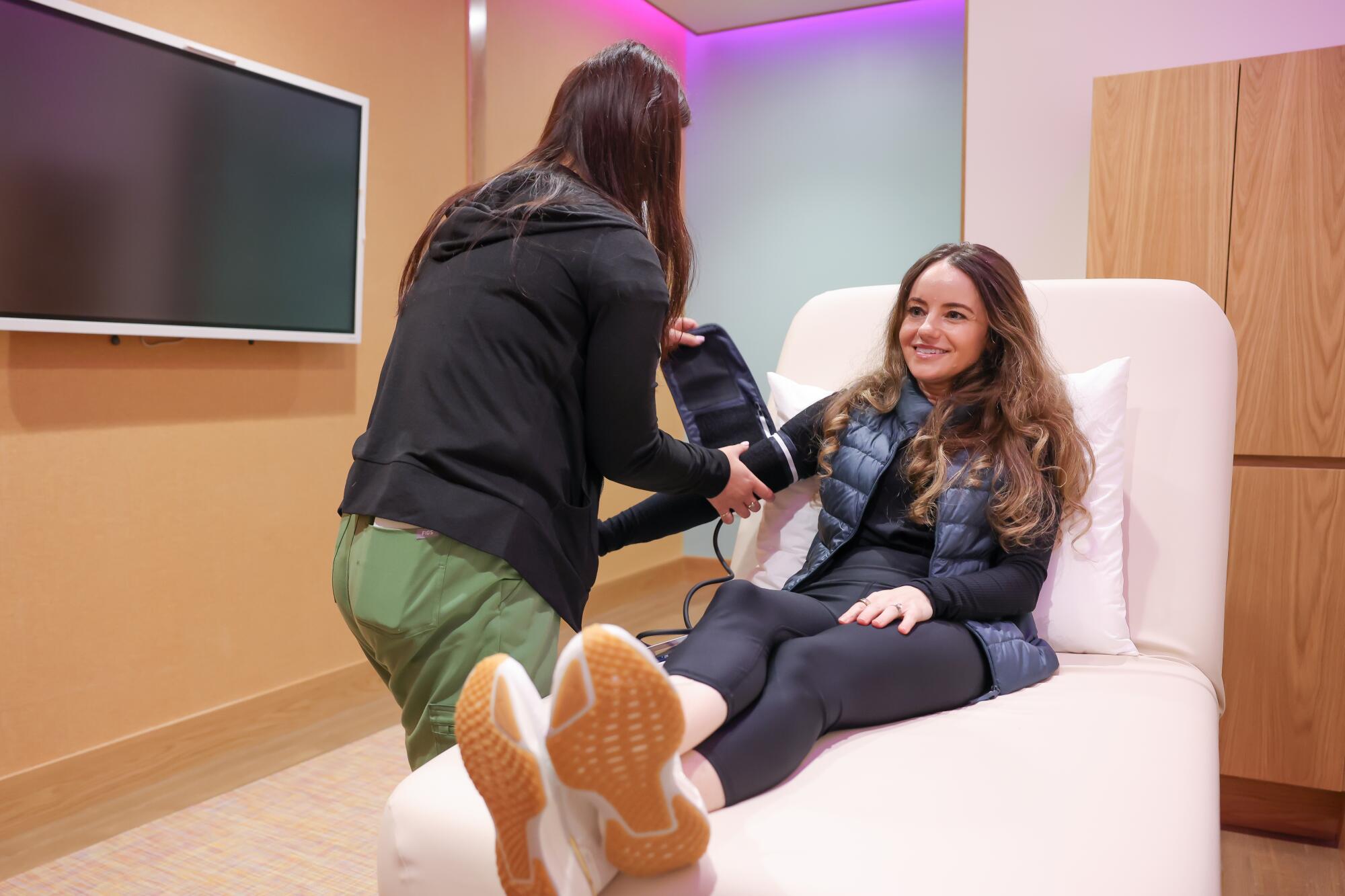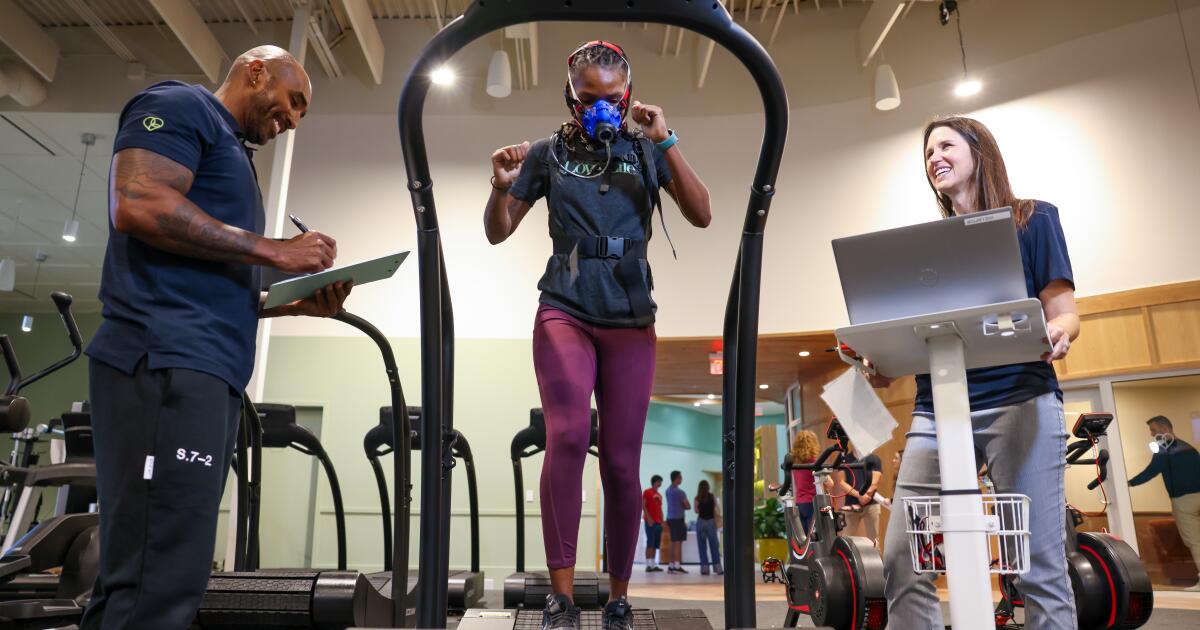I sat in my car, in an El Segundo shopping mall parking lot, looking up at a new storefront touted as a one-stop shop for feeling physically fit, emotionally grounded and socially connected. My shoulder ached. It was my good luck that on the same day I was touring Love.Life — a new luxury health center conceived by John Mackey, co-founder of Whole Foods Market — I was also nursing a gym injury.
After weeks of navigating our infuriatingly slow medical system, it felt promising, if not surreal, to arrive at the doorstep of an establishment with nearly every treatment I could think of under one roof: diagnostic tests, rejuvenating therapies and fitness and nutrition plans to stave off future health problems.
I walked up to Love.Life’s entrance. Its gleaming picture windows and grass-green exterior might as well have been the gates to the Emerald City, behind which mysterious healing modalities awaited. I clicked my heels together — I happened to be wearing red suede sneakers — and mumbled to myself: “There’s no place like a posh, membership-only holistic health club.” Then I headed inside, passing under block lettering that read: “Nourish Heal Thrive.”
“If this idea won’t work in L.A., it won’t work period,” says Love.Life co-founder John Mackey, also a co-founder of Whole Foods Market.
The lobby was blindingly bright, with porcelain floors and mod furniture in peppy colors. There was a spacious cafe on one side and a futuristic gym on the other, animated by various blinking screens. Around the corner were what looked like red-white-and-blue space pods. What they were for, I had no idea.
“Hi there,” said a receptionist at a clinically simple desk. Was I in the lobby of a boutique hotel? A doctor’s office? Or was this an astronaut training center? Or all of the above?
The idea for this lavish temple of wellness had been swirling in the back of Mackey’s brain for almost four decades. After co-founding Whole Foods in 1980, and growing the natural and organic foods store into an international network of more than 460 outlets, Mackey and company sold the publicly traded company to Amazon in 2017 for $13.7 billion.
For his next venture, the vegan breathwork enthusiast and pickleball lover wanted to “change the way people think about health and wellness,” he told me a few weeks earlier when I met him at the not-yet-finished Love.Life space. “This is a continuation of my own higher purpose in life.”
Mackey left Whole Foods in 2022 but had already started working on plans for the club a year earlier. (It’s part of a multipronged parent company, Love.Life, that he co-founded in 2020.)
Over the last three years, he and his Love.Life co-founders — Whole Foods former Chief Executive Walter Robb and longtime executive Betsy Foster — transformed his dream into a reality: a swanky, holistic health center that’s part state-of-the-art gym, part high-end spa, part highly personalized doctor’s office and part exclusive social club. It touts specialists in both Eastern and Western modalities as well as an on-site physical therapy clinic. Its “plants-forward” cafe serves superfood-filled dishes with names like Ocean Bowl and Green Tartine. Regular live events include meditations, soundbaths and breathwork classes. Love.Life even has three indoor pickleball courts.
If successful, Mackey envisions other centers in other cities before expanding internationally. But for now, the flagship Love.Life opens Saturday adjacent to — you guessed it — a palatial Whole Foods Market.
“If this idea won’t work in L.A., it won’t work period,” Mackey says. “People here are more into their health, they’re more into looking good, feeling good, they’re into longevity.”

Love.Life personal trainer Shelle Tarver plays on the pickleball court.

Love.Life team members demonstrate poses in a yoga class.

Love.Life team members Marcie Icovino, center, and Maddy Isbell demonstrate Pilates equipment.
Love.Life’s mission is to help its members live longer, healthier lives by deep-diving into their health history, executing an array of specialized tests and then suggesting fitness and lifestyle changes, paired with as many preventive health measures as humanly possible.
“We’re trying to help individuals become the healthiest, best versions of themselves — physically, emotionally and spiritually,” Mackey, dressed in jeans and a Love.Life-branded polo, says. “When do most people go to a doctor? When they get sick. Our idea is: We want you to start seeing a doctor 1723854408 so that you don’t ever have to see a doctor for the chronic diseases that kill.”
There’s a good reason most people in America don’t see a doctor until they feel ill or, say, experience shoulder pain. Our country’s healthcare is often prohibitively expensive and difficult to navigate. The “individuals” Mackey aims to help, Love.Life’s target market, are those with deep pockets who can afford to circumvent the system.
A Love.Life core membership starts at $750 a month for a “High Performance,” “Heal” or “Longevity” membership, depending on the goal. This includes five visits a year with a Love.Life primary care doctor, as well as health coaching, medical testing, fitness and recovery services and access to practitioners across 20-plus disciplines including traditional Chinese medicine, sports performance, yoga and nutrition. The membership cost tops out at the “Concierge” level, which costs $50,000 a year and includes unlimited doctor visits, 24/7 care and the most detailed level of medical testing the facility offers. There are also limited memberships, such as a medical-only or fitness and recovery-only membership for $500 a month and $300 a month, respectively.

Cold vapor billows out of a cryotherapy chamber as the author steps in.

A red-light lamp offers the author collagen stimulation.
Upon enrolling, members can undergo a series of tests so facility specialists have a 360-degree view of their health. It’s a journey into the bodily unknown. They may draw blood for an advanced lab panel measuring more than 120 biomarkers, have their musculoskeletal layer assessed or undergo a DEXA body composition assessment and bone mineral density scan. Other specialty tests address the microbiome, hormone health, cardiac health and food sensitivities, among other things.
From there, Love.Life experts put together a personalized fitness, nutrition and lifestyle plan for the member, which they can follow at the facility’s gym or through various treatments. Red-light therapy beds to support healing? Check. Breathwork class to manage stress? Check. Hyperbaric oxygen therapy pods to reduce inflammation? You’d better believe it.
Members book all appointments on an app, which also stores their health history and tracks fitness progress. They can use it to share that information with any of Love.Life’s practitioners, reserve a pickleball court, book a massage or order lunch.

The Ocean Bowl at Love.Life is packed with superfoods, like blue spirulina, cacao and chia seeds. Though memberships to the wellness club start at $300 a month, anyone can visit its cafe.
Some parts of Love.Life will be open to the public, such as the cafe, select healing therapies and the spa, for which anyone can buy a $100 day pass. But Mackey emphasizes that membership and community are key to the experience.
“If you have friends with good habits, you’re gonna pick that up,” he says.
That 1-percenter healthy living also comes with its fair share of window dressing. In designing the 45,000-square-foot space, Mackey says Love.Life worked with an acoustical engineer to manage the sound flow. Passing from the airy, bustling lobby and cafe area into the spa, the halls narrow and the lights dim. A preserved-moss wall absorbs ambient sound but for a gurgling fountain and soothing music. Crystals, mirrors and chimes were ensconced in its walls per the advice of a Feng Shui expert. A warm Turkish Hammam Table gives visitors a place to stretch and lounge opposite a wall-sized fountain.

The preserved-moss wall at Love.Life absorbs ambient sounds to keep the spa quiet.

The author reclines for a resting metabolic rate assessment, measuring energy expenditure and caloric burn at rest, attended by physical therapist Danél Lombard, center, and Davon Murray, an exercise physiologist.
I paid a $100 visitor fee to enter and relaxed into a plush, leather Zero Gravity Chair, with heated seats and massage nodes, my head draped backward and my feet pointed high. This was a resting metabolic rate assessment, which measures your energy expenditure and how many calories your body burns at rest (the test was part of my reporting, and is not included with a spa pass). Attendants fitted me with a snug Vo2 max mask, which was synced to a nearby laptop. Then I zoned out for about 20 minutes, nearly falling asleep.
When they returned, I learned exactly how many calories my body needs to think, breathe and otherwise stay alive (not nearly as many as I’d hoped). Had I been a member, I might have met with a Love.Life nutritionist next, to configure my caloric and macronutrient needs to support weight loss or exercise performance.
From there, Love.Life regional president Michael Robertson led me into a private room where I slid my lower limbs into what looked like a space suit while lying on a table. The FDA-cleared Ballancer Pro lymphatic compression therapy, he said, enhances lymphatic drainage to rid the body of toxins and reduces swelling and muscle soreness. Robertson zipped me up and tapped a button before the suit began to swell and squeeze my legs. It was oddly relaxing.

Love.Life personal trainer Shelle Tarver performs squats on a high-tech OxeFit machine, which gives real-time feedback on power, velocity, load and balance.
Though I skipped the gym during my visit, personal trainer Shelle Tarver was there doing squats on something called an OxeFit machine. She faced a giant, vertical screen on which her digital avatar mirrored her moves and gave her real-time data about her power, velocity load and balance so she could make her workouts more effective.
Finally, it was time to chill out — literally. Robertson led me to what looked like a tall commercial refrigerator bathed in blue and purple light. The cryotherapy chamber was set at minus-120 degrees Fahrenheit. It was so cold that the instant I stepped inside — wearing a face mask, earmuffs and mittens for protection — ice crystals began to form on my nose and snowflakes fell from the ceiling. Cryotherapy is meant to reduce inflammation and increase circulation, Robertson said, but when I stepped out after one minute, I just felt very awake.
Preventive healthcare — spending money to stay well rather than on costly medical bills once sick — is a growing trend. Whether this proactive attitude is a response to America’s sluggish healthcare system or a quest for control at a chaotic time in history is anyone’s guess. But businesses have popped up to meet the desire.
West Hollywood’s Remedy Place offers high-end, holistic “social wellness services,” plus chiropractic and biometric testing; Healthspan, a digital medical clinic, aims to help patients fight aging and chronic disease. Even traditional gyms like Equinox are now offering a $40,000-a-year concierge membership that includes sleep coaching, personal training, massage therapy and nutrition advice.
Love.Life combines all these services into one club — and goes one step further. Its members can use their designated doctor at the club as their primary care provider. The company doesn’t accept insurance, but it does offer a super bill which members can submit for reimbursements if the tests and treatments qualify under their plan. Membership, Mackey clarified, is not meant to replace health insurance, however, which is still necessary for emergencies, among other things.
When Whole Foods opened in 1980, it merged the utilitarian supermarket experience with a hippie-minded desire to nourish oneself from the land. As the brand grew, it became synonymous with a certain crunchy aspirational lifestyle. Whole Foods became more than a place to pick up a carton of milk, it was a place to assert your values, and to feel good. (And spend, as many people joked, your “whole paycheck.”)
Can Mackey find the same success with Love.Life? To thread the same needle in the legendarily opaque realm of healthcare seems a much further stretch. But when your target market has bottomless pockets, a fantasy can become a reality.

Janette Rizk, Love.Life’s communications director, has her blood pressure checked in the medical clinic.
As exciting as that might be for some people, it could have negative effects on the larger population, says Paul Ginsburg, a professor of health policy at USC.
“They’re extending the scope of what medical care is for their wealthy clients,” he says of Love.Life. “If you’re wealthy, it’s a wonderful opportunity. But physician resources are stretched pretty thin today, and if the centers were to take off, engaging physicians in service to very wealthy people means drawing their time away from treating the general population — that’s the downside.”
Mackey hopes that Love.Life will follow in Whole Foods’ philanthropic path. (Whole Planet, a project of the grocery chain’s nonprofit, has invested $113 million in global communities since 2005.)
“Philanthropy comes from success,” Mackey says. “We will do things to help improve the health of poor people. But it’ll come because we’ll have the resources to do that.”

One of Love.Life’s many cold plunge tubs.

Love.Life’s spacious hemlock wood sauna in the spa.
Once my tour was over, I wistfully returned to the parking lot, a strawberry-Ashwagandha smoothie in hand. I’d enjoyed the experience more than I thought I would and longed for Love.Life’s services at my fingertips. After that whirlwind of peculiar chambers and treatments, I wondered if my ailing shoulder even felt a tad more limber.
But would I ever travel down this yellow brick road again? At Love.Life’s price points, likely never.






